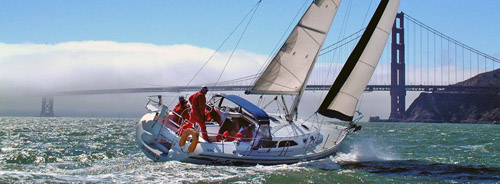I was sitting on a grassy hillside, enjoying a late lunch midway through a stroll around Angel Island. The Golden Gate, the entire central Bay, and the San Francisco skyline were spread out below me.

By Captain Ray
Published: March, 2008
As I sat enjoying food, sun, friends, and the wonderful view, I noticed a sailboat below us engaged in quite a struggle. She was sailing east toward Alcatraz in a light westerly wind, and was rapidly losing ground. While the wind was moving her east, some other force was dragging her backward toward (and eventually under) the Golden Gate Bridge. A quick look at the tide book—yes, I really did have one in my pocket!—showed that there was an ebb current with a velocity of 5.9 knots. What that means is that the water in the Bay was flowing out the Gate at almost six knots. A boat would have to sail in at almost six knots just to stand still! This boat was making maybe 2.5 knots through the water; at the same time she was being carried backwards by the current at about 3.5 knots.
Current is defined as the horizontal movement of water. There are several different types of current; each has its own cause. For example, gravity is the force behind river current, and worldwide wind patterns drive ocean circulation currents. And all mariners here on the Bay have to deal with tidal current, which is the horizontal water movement caused by the tides.
Tide, of course, is the vertical change in water level caused by the gravitational attraction of heavenly bodies. The primary force here is the Moon because it’s close to the Earth, and the Sun because it’s so big. As the relationship between the Sun and Moon changes, the effect of their combined gravities on the Earth’s oceans varies. At times, the Sun and the Moon pull in the same direction (the new and full moons) and their combined effects are greater; at other times, they are at right angles to each other (the first and third quarters) and their effects are much more moderate.
Compounding these effects is the fact that, during the winter, the Sun and the Earth are closer together. Therefore, the effect of gravity is increased. At the time of new and full moons during the winter months, San Francisco Bay experiences the highest and lowest tides of the year. In six or seven hours, the water level will change by more than eight and a half feet at the Golden Gate, and by about half that as far east as Sacramento. This large tidal change causes very great volumes of water to move in, out, and around the Bay in short periods of time, setting up the strongest currents of the year. Whether it is the ferry you ride to and from work each day, a sailboat out for a pleasure cruise, or an oil tanker carrying crude from the North Slope, all vessels are affected by this current equally: all have to deal with it somehow.
The most common way to deal with it is, for many, to just ignore it, see what happens, and deal with the consequences. This is probably the plan used by the boat we watched from our lunch spot. Clearly, it wasn’t the best way to go. Publications (both in print and online) give the times and heights of tides and the times, velocities, and directions of the currents caused by those tides. Accessing this information would have allowed the skipper of this hapless sailboat to formulate a plan that would have been much better than being carried out the Gate backwards!
Ray Wichmann,
is a US SAILING-certified Ocean Passagemaking Instructor, a US SAILING Instructor Trainer, and a member of US SAILING’s National Faculty. He holds a 100-Ton Master’s License, was a charter skipper in Hawai’i for 15 years, and has sailed on both coasts of the United States, in Mexico, the Caribbean, and Greece. He is presently employed as the Master Instructor at OCSC Sailing in the Berkeley Marina.
